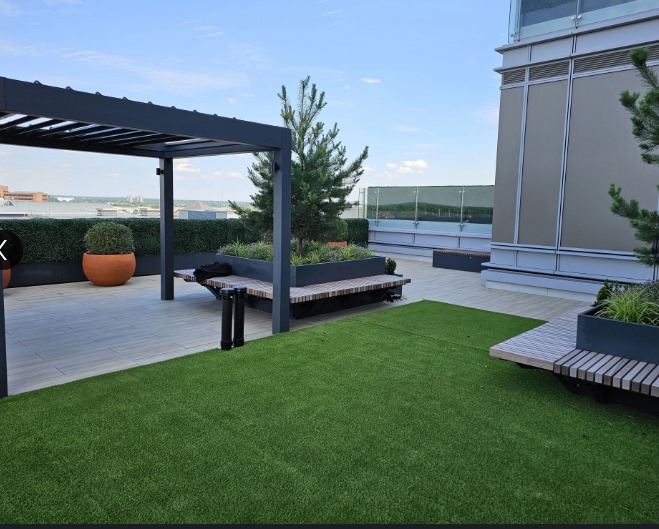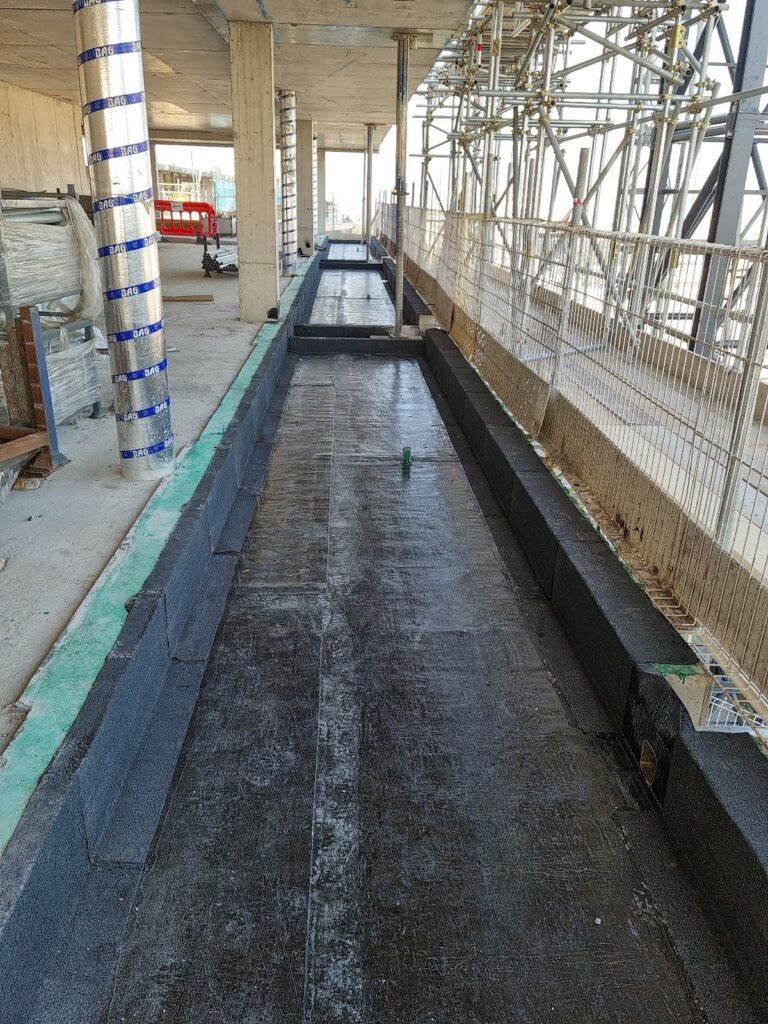Hot melt waterproofing systems are crafted to deliver toughness, reliability, and exceptional performance, surpassing the lifespan of structures.
They provide robust and enduring waterproofing solutions for high-traffic roof areas. The resilience and longevity of hot melt structural waterproofing systems ensure a risk-free waterproofing experience, eliminating the need for potential replacement costs and guaranteeing a leak-free roof for the entirety of the structure’s existence.
These systems can be installed at zero falls, making them ideal for inverted roofs, podium decks, terraces, green roofs, car parks, and civil engineering structures.
These systems are highly durable and can withstand extreme weather conditions, UV exposure, and foot traffic, ensuring long-term protection for the building.
Hot melt roofing systems provide a seamless membrane that effectively waterproofs the entire roof surface, reducing the risk of leaks and water damage.
Long-term durability and low maintenance requirements can result in significant cost savings over the life of the roof.
Hot melt is resistant to punctures, tears, and chemical damage, reducing the need for frequent repairs and extending the lifespan of the roof.
Tamaris Roofing has developed a one-of-a-kind, developed, second-generation polymer-modified
hot melt bitumen composites that provide resilient, continuous, self-healing, and adaptable
waterproofing efficient of enduring construction traffic and heavy-duty finishes. The progressive
second-generation hot melt systems from Tamaris Roofing offer unmatched advantages compared
to competitors.
Hot Melt systems are chosen for their fast and easy fitting and everlasting performance qualities.
They offer continuous, immovable waterproofing, removing lap failure and the prospect of water
tracking beneath the system. The adaptable liquid treatment of hot melt systems allows for
multifaceted detailing to be accomplished promptly and successfully, offering secure protection
across all areas.


An electric mixer can be used for hot melt roofing and it provides a convenient, efficient, and cost-effective solution for mixing roofing materials, ultimately contributing to the success and quality of roofing projects.
Using an electric mixer has many operational and environmental benefits, including:
The major harmful emissions from burning LPG are similar to those from other internal combustion engines: Carbon monoxide (CO) Hydrocarbons (HC) Nitrogen oxides (NOx). 1 kg of LPG produce 3 kg of CO 2 .
Learn more about the Hot Melt Code of Practice

The buildings and construction sector stands as the foremost contributor to greenhouse gas emissions, representing an overwhelming 37% of the total global emissions. Given its significant contribution to climate change, addressing emissions within our projects is paramount to achieving sustainability goals and mitigating the impacts of global warming.
The built environment, with the construction sector playing a pivotal role, presently accounts for approximately 40% of the UK’s carbon emissions. Moreover, estimates suggest that the construction sector contributes up to 11% of global carbon emissions. This underscores the significant impact of construction activities on carbon footprints, highlighting the urgent need for sustainable practices and innovations within the industry to mitigate climate change.
Self-Adhesive Roofing Felt requires no flames during installation, enhancing safety and simplifying the application process. It is manufactured from a polyester base with an SBS (Styrene Butadiene Styrene) bitumen coating.
The release film protects the underside of the sheet and can be easily removed during installation, in compliance with BS 8217: 2005, ‘Code of Practice for Reinforced Bitumen Membranes for Roofing.
The self-adhesive properties eliminate the need for gas torches, hot works, hot bitumen, and other messy sealants, making installations simpler and less time-consuming.
Single layer or multi-layer systems are ideal for roofing applications such as porches, garages, extensions, and dormer windows. They are also suitable for larger-scale projects due to their easy, no-fire installation.
Whether roller-applied, poured, or sprayed, the adhesives used to create warm roof insulated systems are flexible and feature high bond strengths. As a responsible and diligent roofing company, Tamaris Roofing is committed to ensuring the safest possible installation methods for our employees, clients, and the industry.
When a fully built-up system is utilised, primers, activators, torch-free membranes, and insulation adhesives can all be employed. Primers must be suitable for application in any season to ensure an adequate bond that resists wind uplift, with activators available to strengthen this bond.
Advanced self-adhesive technology is used in bitumen membranes for bonding to the substrate. The factory-applied adhesive is protected by a thin release film to prevent sticking inside the roll. During application, the installer uses the peel-back release film to unroll the membrane onto the surface.
The laps are welded using heat, and a visible bitumen bead from the welded laps indicates a secure and robust installation.

Lifetime emissions from the site should be net zero. Although these sites are generally considered to have a positive impact on emissions reduction because of the production of renewable electricity, there is still the need to ensure that lifetime emissions from the construction, operation and decommissioning of sites are minimised, by for example electrifying the construction and maintenance fleet or by offsetting embedded emissions from the production and construction of the site.
All ancillary buildings onsite should also aim to be net zero. Low carbon construction materials and practices should also minimise the carbon footprint of the development e.g. by local procurement and minimising transport of materials; also supporting the local economy and green growth and seeking to maximise social value benefits throughout the project lifetime in procurement, construction and operation processes. Solar developments should also contribute to the greening of the local economy through increasing green jobs, and green sector skills through upskilling their workforce for example, as these skills will be transferable for both large- and small-scale solar installations. This will also support the Essex Climate Action Commission recommendation to “make Essex a centre of innovation for emerging renewable technologies (e.g. small scale nuclear, & manufacturing of renewables products such as solar tiles)”.
For the full article visit The Essex Design Guide. Also visit Essex Climate Commission to learn more.